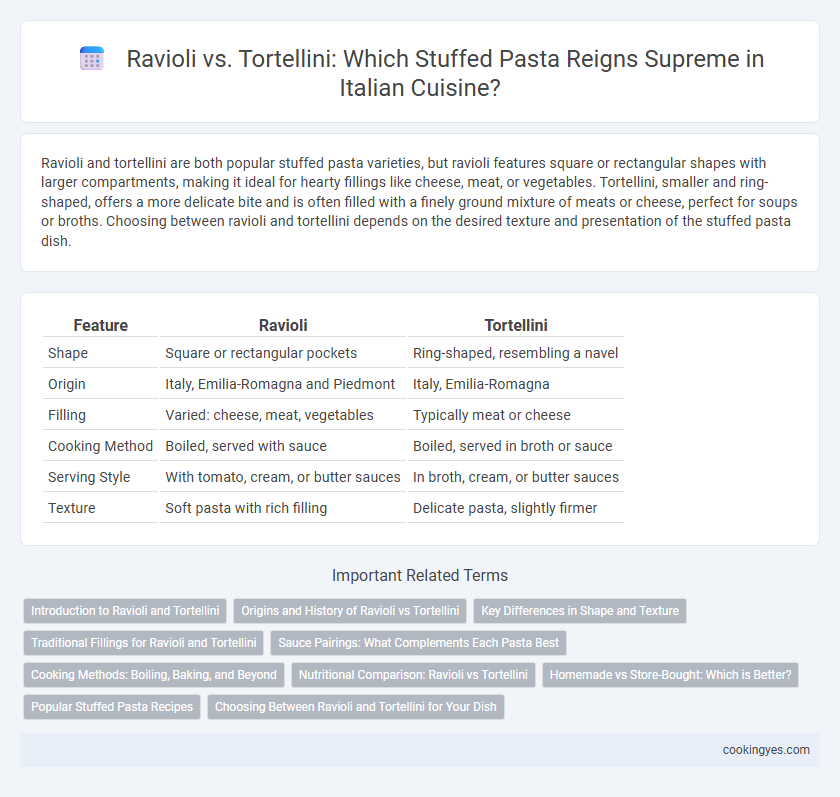Ravioli and tortellini are both popular stuffed pasta varieties, but ravioli features square or rectangular shapes with larger compartments, making it ideal for hearty fillings like cheese, meat, or vegetables. Tortellini, smaller and ring-shaped, offers a more delicate bite and is often filled with a finely ground mixture of meats or cheese, perfect for soups or broths. Choosing between ravioli and tortellini depends on the desired texture and presentation of the stuffed pasta dish.
Table of Comparison
| Feature | Ravioli | Tortellini |
|---|---|---|
| Shape | Square or rectangular pockets | Ring-shaped, resembling a navel |
| Origin | Italy, Emilia-Romagna and Piedmont | Italy, Emilia-Romagna |
| Filling | Varied: cheese, meat, vegetables | Typically meat or cheese |
| Cooking Method | Boiled, served with sauce | Boiled, served in broth or sauce |
| Serving Style | With tomato, cream, or butter sauces | In broth, cream, or butter sauces |
| Texture | Soft pasta with rich filling | Delicate pasta, slightly firmer |
Introduction to Ravioli and Tortellini
Ravioli are square or circular pillows of pasta typically filled with cheese, meat, or vegetables, known for their larger size and simpler folding technique. Tortellini are ring-shaped or navel-shaped pasta stuffed with a blend of meats, cheeses, and spices, distinguished by their smaller size and intricate folding that creates a distinctive plump look. Both ravioli and tortellini serve as versatile bases for stuffed pasta dishes, offering varied textures and flavor profiles ideal for rich sauces or broths.
Origins and History of Ravioli vs Tortellini
Ravioli, originating from the Lombardy and Veneto regions of Italy, trace back to the 14th century as a staple filled pasta often served in broth. Tortellini, hailing from Emilia-Romagna, especially Bologna and Modena, boast a history linked to Roman times and are famously shaped like a navel, symbolizing local folklore. Both stuffed pasta varieties reflect distinct regional culinary traditions deeply rooted in Italian gastronomic culture.
Key Differences in Shape and Texture
Ravioli typically features a square or circular shape with flat pasta sheets enclosing the filling, creating a smooth and tender texture that eases the bite. Tortellini, on the other hand, forms a ring or navel-like shape by folding and wrapping the dough around the filling, resulting in a firmer texture and a more compact bite. These shape and texture differences impact their respective sauces and cooking times, with ravioli generally pairing with lighter sauces and tortellini complementing richer, creamier sauces.
Traditional Fillings for Ravioli and Tortellini
Traditional ravioli fillings often include ricotta cheese blended with spinach, mushrooms, or meat such as veal and pork, creating a rich, creamy texture inside delicate pasta pillows. Tortellini typically feature a savory filling made from a mixture of prosciutto, mortadella, and Parmesan cheese, emphasizing a balanced, robust flavor profile. Both types of stuffed pasta showcase regional Italian ingredients, with ravioli leaning towards vegetable and cheese combinations while tortellini highlight cured meats and aged cheese blends.
Sauce Pairings: What Complements Each Pasta Best
Ravioli pairs exceptionally well with lighter sauces like sage butter or tomato basil, which enhance its delicate fillings without overpowering them. Tortellini, known for its denser texture and rich fillings, complements cream-based sauces such as Alfredo or a hearty Bolognese. Selecting the right sauce accentuates the unique flavors and textures of each stuffed pasta, elevating the overall dish experience.
Cooking Methods: Boiling, Baking, and Beyond
Ravioli and tortellini both excel when boiled, retaining their delicate fillings and tender pasta texture, but ravioli's larger size makes it ideal for baking in layered dishes like casseroles or lasagna-style bakes that enhance flavors through caramelization. Tortellini's smaller, ring-shaped form lends itself well to quick boiling and incorporation into soups or creamy sauces, where its compact shape absorbs flavors efficiently. Experimenting with pan-frying boiled ravioli or sauteing tortellini can add crisp textures, expanding traditional cooking methods beyond mere boiling for stuffed pasta varieties.
Nutritional Comparison: Ravioli vs Tortellini
Ravioli typically contains a higher carbohydrate content due to its larger pasta pockets, while tortellini offers more protein per serving, often filled with cheese or meat. Both pasta types provide essential nutrients like iron and calcium, but tortellini usually has fewer calories and less fat, making it a lighter option for stuffed pasta dishes. Nutritional values, however, can vary significantly depending on the specific fillings and preparation methods used.
Homemade vs Store-Bought: Which is Better?
Homemade ravioli and tortellini offer superior freshness and customizable fillings compared to store-bought options, allowing for unique flavor combinations and higher quality control. Store-bought stuffed pasta provides convenience and consistent shape, but often lacks the delicate texture and artisanal taste achieved through handcrafting. For pasta enthusiasts prioritizing authenticity and rich flavors, homemade ravioli or tortellini elevates stuffed pasta dishes beyond mass-produced varieties.
Popular Stuffed Pasta Recipes
Ravioli and tortellini are both iconic Italian stuffed pasta varieties, with ravioli featuring square shapes typically filled with ricotta, spinach, or meat, while tortellini are ring-shaped and often stuffed with a blend of pork, prosciutto, and Parmesan. Popular stuffed pasta recipes like classic cheese ravioli served in a rich marinara sauce and tortellini alla panna, cooked with cream and mushrooms, highlight their distinct flavors and textures. Both pasta types showcase versatility in fillings and sauces, making them staples in Italian cuisine and beloved choices for hearty, flavorful meals.
Choosing Between Ravioli and Tortellini for Your Dish
Ravioli features larger, square or circular pasta pockets ideal for holding a variety of fillings like ricotta, spinach, or meat, making it perfect for hearty sauces and baked pasta dishes. Tortellini, smaller and ring-shaped, typically contains a blend of meats or cheese and excels in soups or light broths due to its delicate size and rich flavor. Choosing between ravioli and tortellini depends on your dish's texture and sauce preferences, with ravioli offering a robust bite and tortellini delivering an elegant, bite-sized option.
Ravioli vs tortellini for stuffed pasta dishes Infographic

 cookingyes.com
cookingyes.com